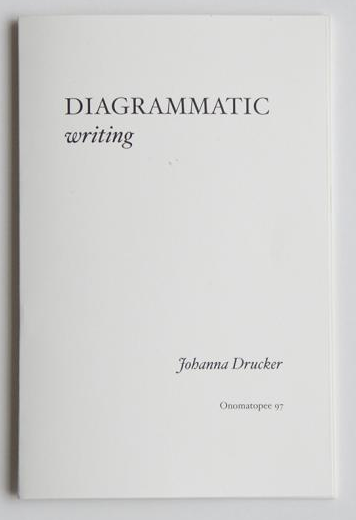Ben van Berkel, Caroline Bos (eds.): ANY, 23: Diagram Work: Data Mechanics for a Topological Age (1998)
Filed under magazine | Tags: · abstract machine, architecture, diagram, fold, philosophy, representation, theory, topology

A special issue of the magazine ANY (Architecture New York) focusing on the diagram and diagrammatics (page 14 onwards).
With contributions by Ben van Berkel and Caroline Bos, Stan Allen, R.E. Somol, Peter Eisenman, Manuel De Landa, Christine Buci-Glucksman, Andrew Benjamin, Karl Chu, Brian Massumi, Greg Lynn, Mark Rakatansky, Sanford Kwinter, and Wes Jones.
Publisher Anyone Corporation, June 1998
ISSN 10684220
62 pages
via waskleist
Commentary: Hélène Frichot (2011).
PDF (13 MB)
Comment (0)Johanna Drucker: Diagrammatic Writing (2013)
Filed under artist publishing | Tags: · book, diagram, gestalt theory, graphic design, text, writing

“This is a book that is as close as possible to being entirely about itself.”
Diagrammatic Writing is a poetic demonstration of the capacity of format to produce meaning. The articulation of the codex, as a space of semantically generative relations, has rarely (if ever) been subject to so highly focused and detailed a study. The text and graphical presentation are fully integrated, co-dependent, and mutually self-reflexive.
This small book work should be of interest to writers, bibliographers, designers, conceptual artists, and anyone interested in the meta-language of diagrammatic thought in graphic form.
Edited, written and designed by Johanna Drucker
Online edition: /ubu editions, Visual Writing series
Printed edition: Onomatopee, Eindhoven; Cabinet Project, 97
Creative Commons BY-NC License
32 pages
via UbuWeb
Commentary: Johanna Drucker (Iowa Review, 2014).
PDF (updated on 2018-12-31)
Comment (0)Nikolaus Gansterer (ed.): Drawing A Hypothesis: Figures of Thought (2011)
Filed under book | Tags: · abstraction, art, contemporary art, data visualisation, diagram, drawing, image, knowledge, perception, representation, research, science, theory

“Drawing a Hypothesis is a reader on the ontology of forms of visualizations and on the development of the diagrammatic view and its use in contemporary art, science and theory. In a process of exchange with artists and scientists, Nikolaus Gansterer reveals drawing as a media of research enabling the emergence of new narratives and ideas by tracing the speculative potential of diagrams. Based on a discursive analysis of found figures with the artists’ own diagrammatic maps and models, the invited authors create unique correlations between thinking and drawing. Due to its ability to mediate between perception and reflection, drawing proves to be one of the most basic instruments of scientific and artistic practice, and plays an essential role in the production and communication of knowledge. The book is a rich compendium of figures of thought, which moves from scientific representation through artistic interpretation and vice versa.”
Translation: Veronica Buckley, Aileen Derieg
Publisher Springer, 2011
Edition Angewandte
ISBN 3709108020, 9783709108024
352 pages
Review: Mark Robert Doyle, Gert Hasenhuetl (in German).
PDF (updated on 2021-12-17)
Comments (4)
